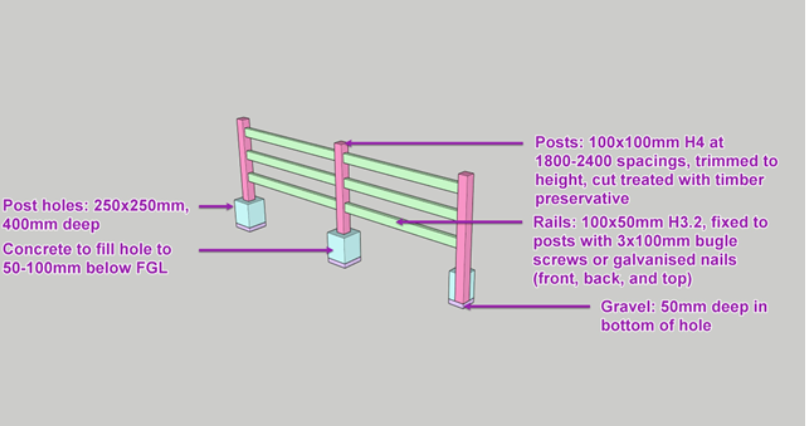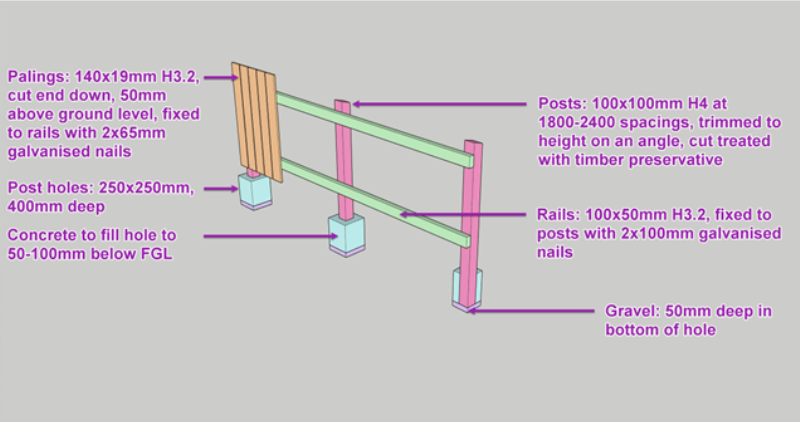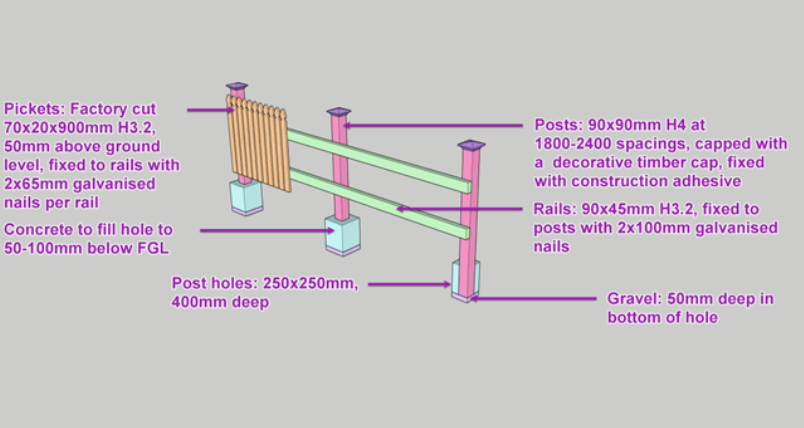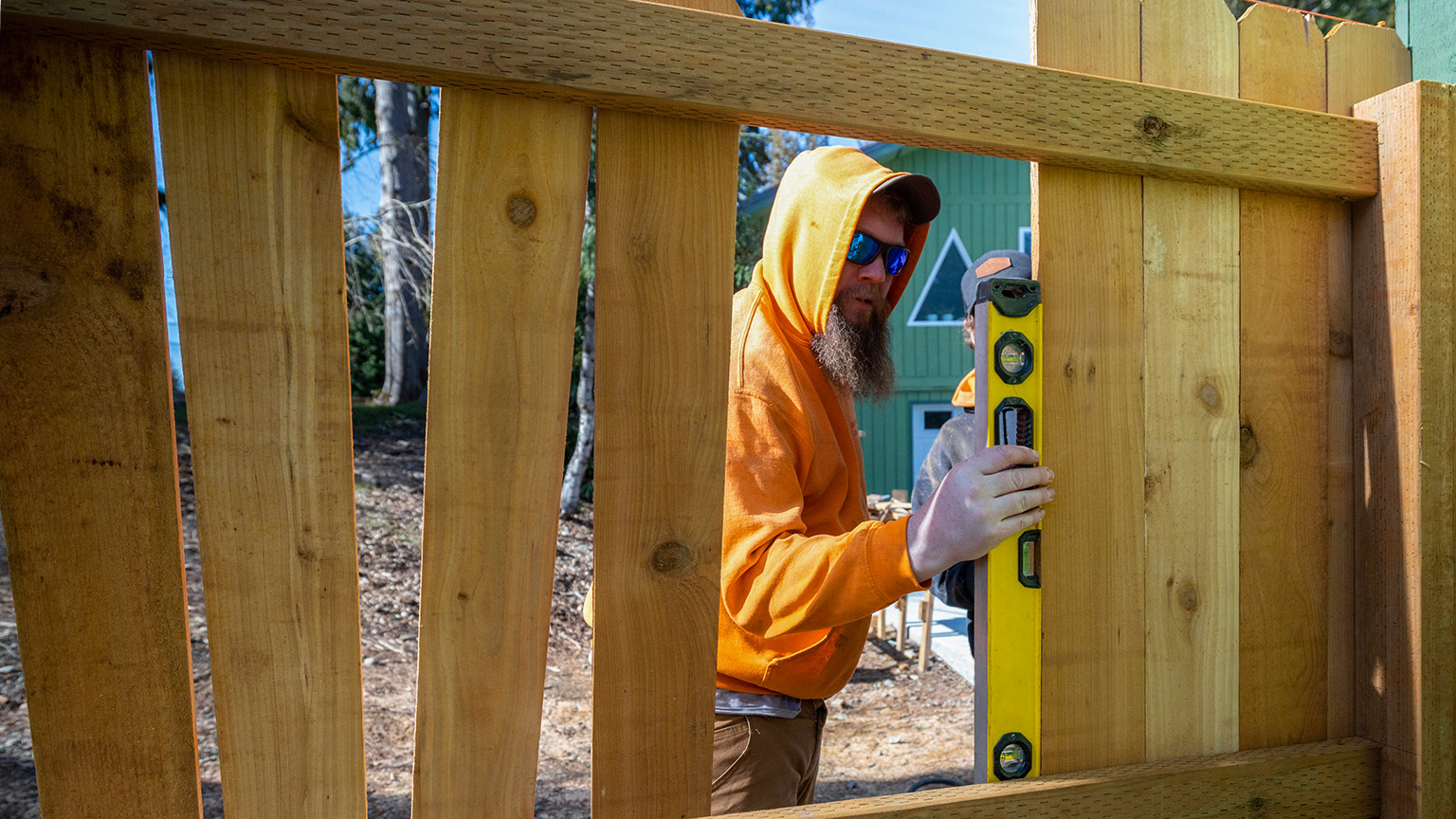In this topic we’ll explore the common specifications for three of the most common low timber fences and how to build one.
By the end of this topic you’ll be able to build a low timber fence, according to accepted industry practices.
When we talk about a low timber fence, we are referring to one that is 1200mm or less tall above finished ground level. Taller fences will require more digging, bracing, and overall precision throughout their construction. If you feel confident in your ability to build a taller one you are welcome to, but make sure it adheres to your local planning regulations.
Let's look at the most common specifications for the following three low timber fences:
- post and rail fence
- post, rail, and paling fence
- picket fence.

Common specification for 900mm high post and rail fence from rough sawn timber.
Finished ground level (FGL) is the level once the ground has been landscaped, such as the lawn has been established or a garden created.

Common specification for 1200mm high post, rail, and paling fence from rough sawn timber.

Common specification for 900mm high picket fence from dressed timber. A picket fence is essentially just a post, rail, and paling fence, but the palings are decoratively cut timber which is spaced a little further apart. Generally picket fences are constructed entirely from dressed timber.
Taller fences
If you are building a fence that is more than 1200mm tall, you will need to install the posts further into the ground. As a general rule:
- 1500mm tall fences, posts should be 500mm deep
- 1800mm tall fences, posts should be 600mm deep.
Fence design for wind protection
If you are building to help block out the wind, refer to this BRANZ publication, which we introduced earlier in the programme: Design right: Don’t blow me over. Adjust the most relevant common specification, above, based on the advice in the BRANZ guide, and your design theme.
Activity: Preparing construction documents for a timber fence
If you’ve chosen to construct a timber fence for your hard landscaping feature, create a working drawing and bill of materials (BOM) for the fence.
The working drawing will help you explain the project to your assistant and the BOM will give you the information you need to order the materials.
Your working drawing can be orthographic, isometric, or perspective, and can be done with pen on paper or inside SketchUp.
We recommend you use the Bill of Materials template for your BOM.
Let's take a look at how to build one of these fences. In the following video we follow the construction of a 1.8m tall post, rail, and paling fence, but the techniques are relevant to most timber fences.
Watch
How to Build a Fence | Mitre 10 Easy As DIY
Duration: 11:13 minutes
Building a fence is the easiest way to give your property some extra safety, security and privacy from the road or your neighbours. Everyone will see it too, so it's a good reason to make sure it's built well and looks good.
The fence we're building here is a simple post, rail and paling fence. Follow these instructions and with a good plan, you'll be able to do it yourself.
Notes about this video:
- Building a fence – in particular getting the posts and rails assembled – is hard to do by yourself. Get someone to help you, at least with these early stages.
- He refers to checking that the posts, and later the palings are plumb. Plumb means perfectly vertical.
- When marking out the positions of the railings, he uses a chalk line to quickly mark the position on all the posts at once. If you don’t have a chalk line, just use a stringline and pencil to make the marks.
- It is possible to nail your palings in place with a hammer, however, if you have a lot to do you might prefer to hire a nail gun. To fix fence palings in place you’ll need a framing nail gun, also called a framing nailer. There is another type of nail gun, called a finishing nail gun, but these won’t have the power you need.
Download a copy of the Construct and maintain a basic residential timber fence as a BCATS project for a helpful step-by-step guide to building and maintaining timber fences.
Assessments 1 and 2
If you’ve chosen to build a timber fence for your hard landscaping feature, you should be ready to make a start.
Head over to the assessments section and read the full assessment requirements in detail. If you have any questions, contact your tutor.
